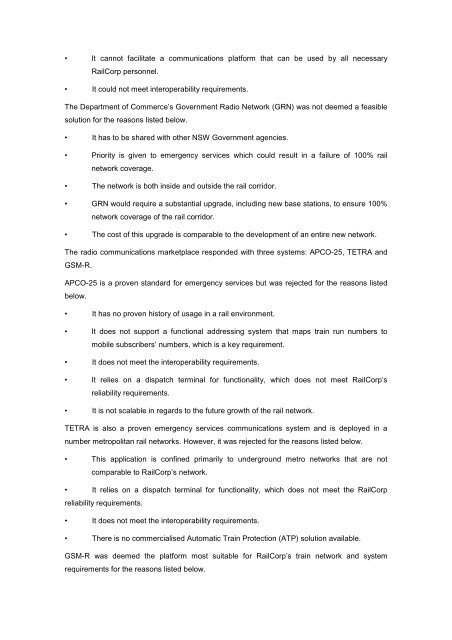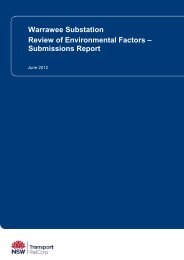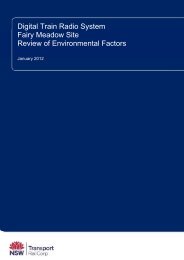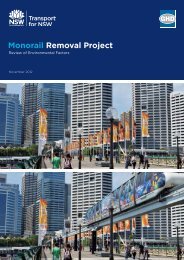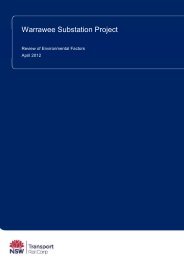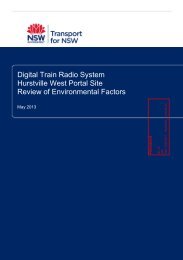Digital Train Radio System Como Site Review of Environmental ...
Digital Train Radio System Como Site Review of Environmental ...
Digital Train Radio System Como Site Review of Environmental ...
Create successful ePaper yourself
Turn your PDF publications into a flip-book with our unique Google optimized e-Paper software.
• It cannot facilitate a communications platform that can be used by all necessary<br />
RailCorp personnel.<br />
• It could not meet interoperability requirements.<br />
The Department <strong>of</strong> Commerce’s Government <strong>Radio</strong> Network (GRN) was not deemed a feasible<br />
solution for the reasons listed below.<br />
• It has to be shared with other NSW Government agencies.<br />
• Priority is given to emergency services which could result in a failure <strong>of</strong> 100% rail<br />
network coverage.<br />
• The network is both inside and outside the rail corridor.<br />
• GRN would require a substantial upgrade, including new base stations, to ensure 100%<br />
network coverage <strong>of</strong> the rail corridor.<br />
• The cost <strong>of</strong> this upgrade is comparable to the development <strong>of</strong> an entire new network.<br />
The radio communications marketplace responded with three systems: APCO-25, TETRA and<br />
GSM-R.<br />
APCO-25 is a proven standard for emergency services but was rejected for the reasons listed<br />
below.<br />
• It has no proven history <strong>of</strong> usage in a rail environment.<br />
• It does not support a functional addressing system that maps train run numbers to<br />
mobile subscribers’ numbers, which is a key requirement.<br />
• It does not meet the interoperability requirements.<br />
• It relies on a dispatch terminal for functionality, which does not meet RailCorp’s<br />
reliability requirements.<br />
• It is not scalable in regards to the future growth <strong>of</strong> the rail network.<br />
TETRA is also a proven emergency services communications system and is deployed in a<br />
number metropolitan rail networks. However, it was rejected for the reasons listed below.<br />
• This application is confined primarily to underground metro networks that are not<br />
comparable to RailCorp’s network.<br />
• It relies on a dispatch terminal for functionality, which does not meet the RailCorp<br />
reliability requirements.<br />
• It does not meet the interoperability requirements.<br />
• There is no commercialised Automatic <strong>Train</strong> Protection (ATP) solution available.<br />
GSM-R was deemed the platform most suitable for RailCorp’s train network and system<br />
requirements for the reasons listed below.


